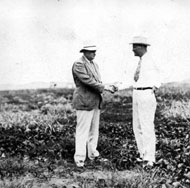In 1868 Pennsylvania
farmer, Henry B. Lum, sailed up the coast from Key West to
Miami to explore the beach wilderness area on the east side
of Biscayne Bay. He saw three palm trees growing on the beach
and they gave him the idea to try his hand at Coconut farming.
With the help of his son, Charles, the Lum's convinced a group
of investors to purchase 165 acres on South Beach for 75 cents
and acre for the purpose of harvesting coconuts.
In 1870 the Beach was little more than a collection of small
islands with sand beaches on the ocean side, dense Palmetto
growth in the middle and mangrove swamps on the bay side.
In 1886, Charles Lum built the first home on Miami Beach;
a two-story house at the site of the present Tides Hotel at
12th Street and Ocean Drive.
The dense mangroves made farming difficult. The mosquitos
they attracted were too much for the laborers to bear and
the men were driven away. By 1894, the coconut venture proved
unprofitable for the Lums, so they left the Beach, leaving
their plantation in the control of
John
Stiles Collins, a wealthy Quaker farmer from New Jersey.
When Henry Flagler extended his railroad south to Miami, John
Collins took the train from his home in Morristown New Jersey,
to inspect his investment. The coconut plantation had been
carved out of beach sand and mangrove swaps which were not
ideal for farming. However, to the west and north of this
area, Collins discovered a ridge on which Pine trees were
growing out of black sand. This indicted there was fresh water
on the island. Collins bought an additional five-mile strip
of land between 14th and 67th Streets and planted bananas,
mangoes, avocados, corn peppers and tomatoes.
At this time, John and James Lummus, each president of a different
Miami bank, began acquiring bay and beachfront land on the
Southern end of Miami Beach. They established The Ocean Beach
Reality Company. Their vision was to build a city fronting
the ocean made up of modest single family residences. The
Lummus Brothers also recognized the need for a good beach
for the tourists which were now pouring into Miami thanks
to the railroad.
The "barrier beach' became a popular recreational spot for
Miami's mainland residents. A ferry operated between Miami
and the Beach. A bathing pavilion called Tatum Pavilion was
connected to the ferry by a wooden boardwalk, which cut through
the mangroves. The Tatum Pavilion represents the first permanent
facilities built to accommodate recreational activities on
Miami Beach.














